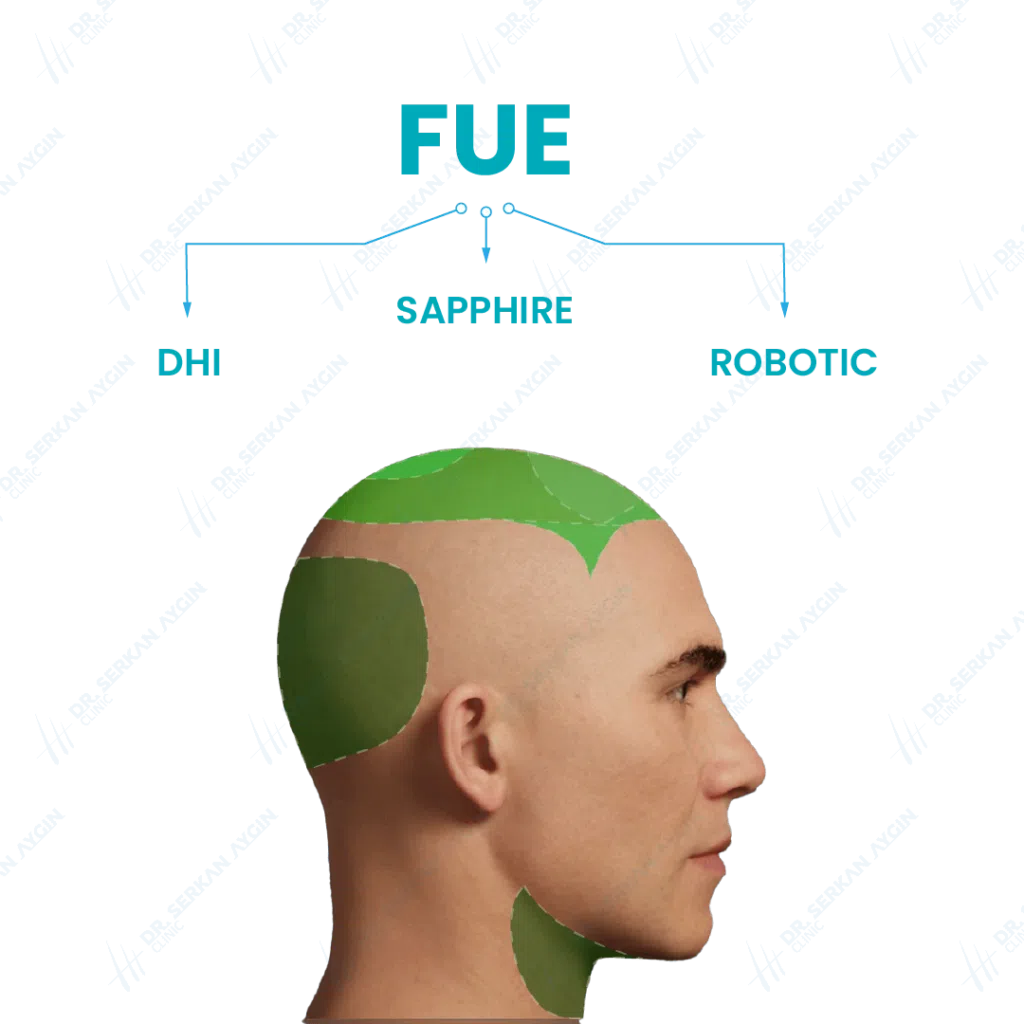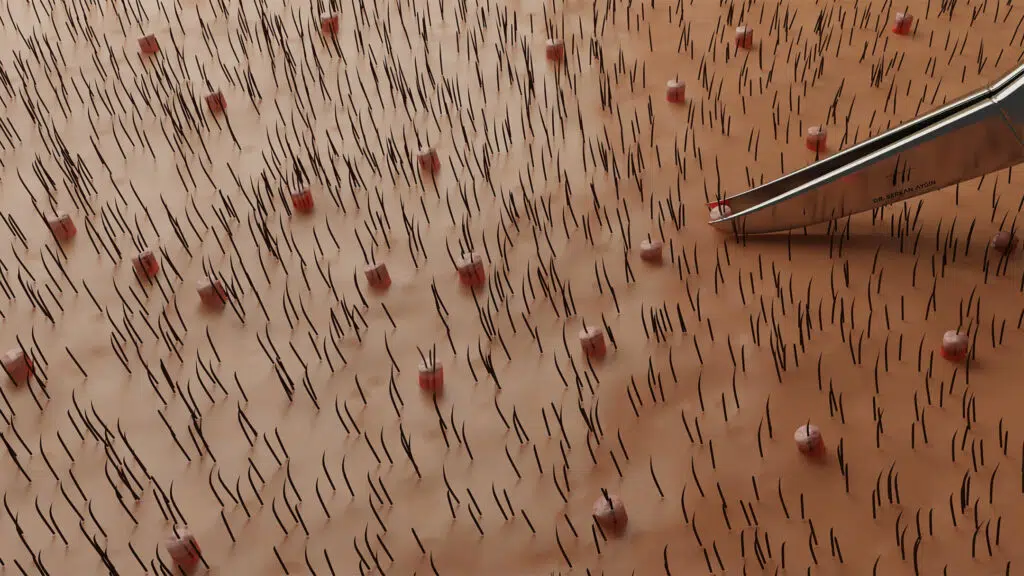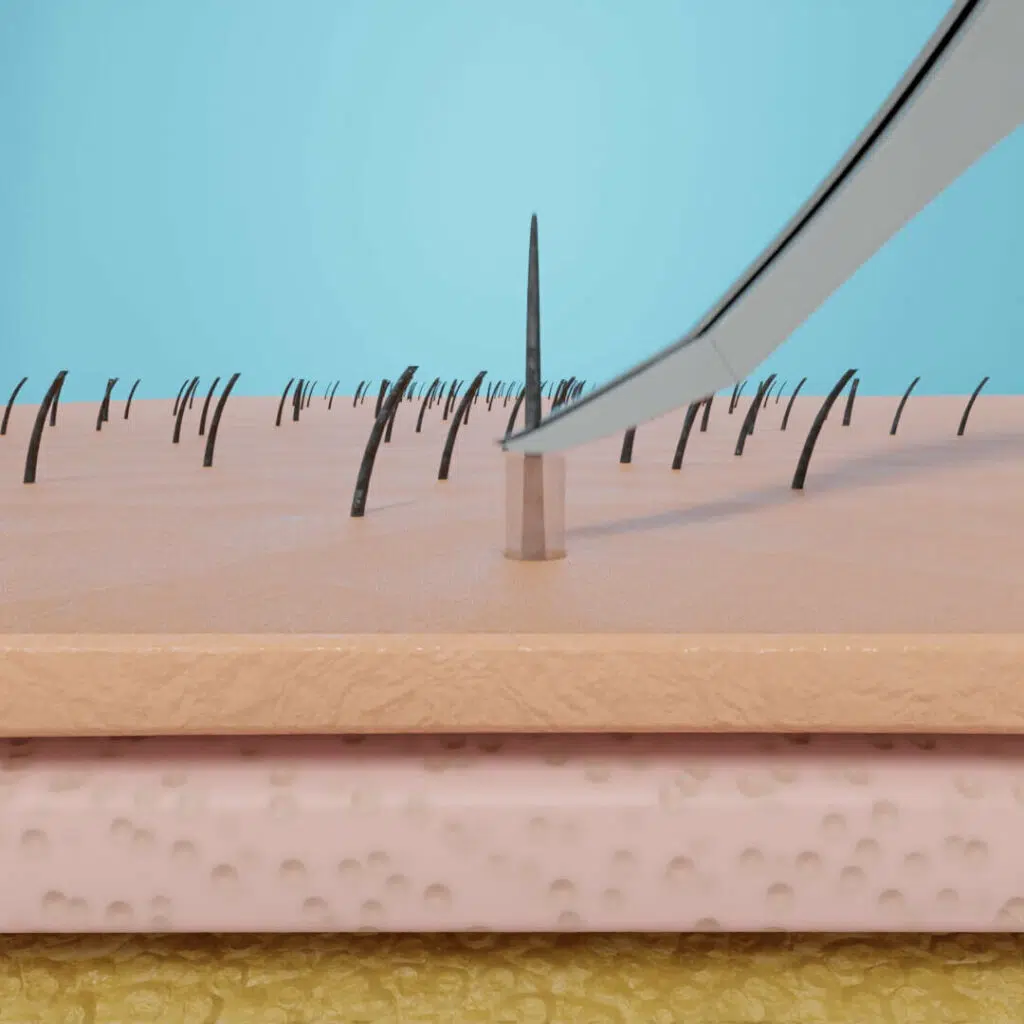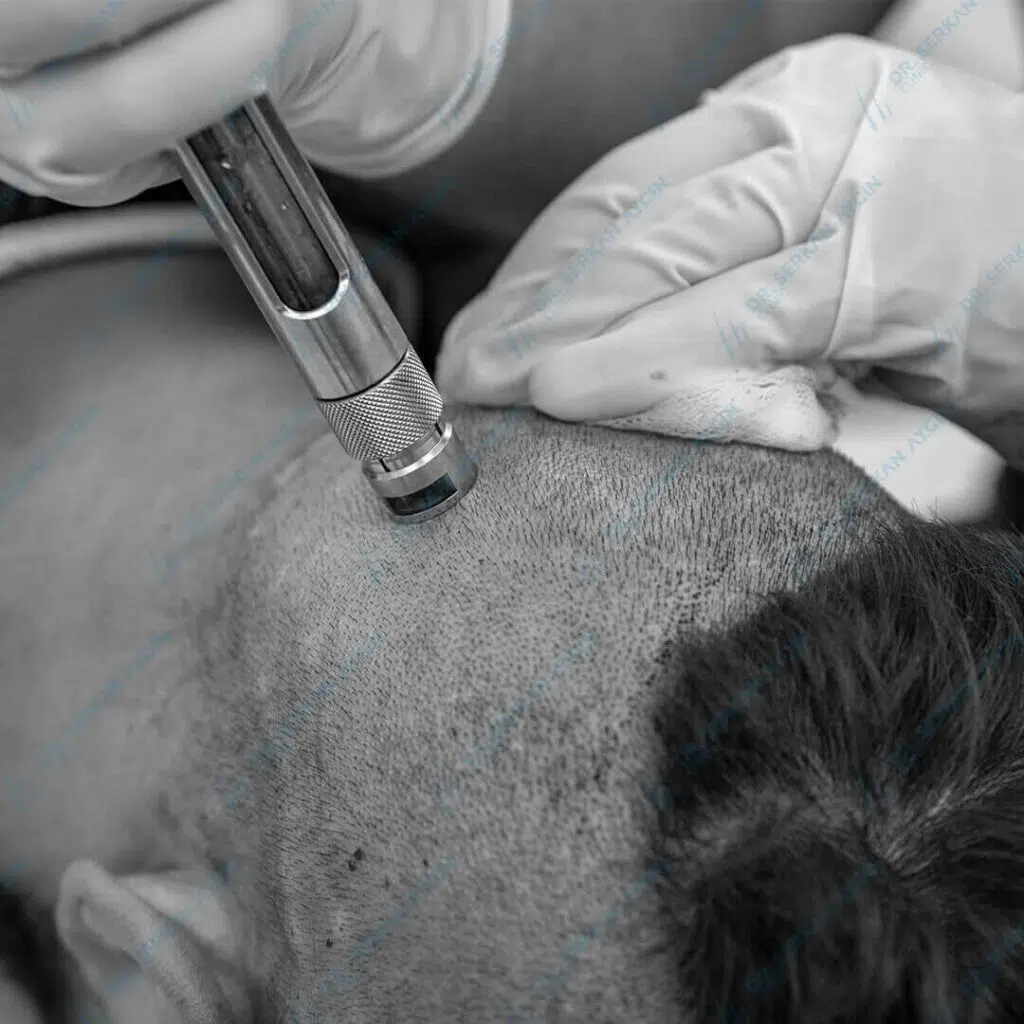مع التقدم الهائل في مجال زراعة الشعر ونتائجها المذهلة، أصبحت زراعة الشعر إحدى التقنيات الرائدة والمفضلة لعلاج تساقط الشعر ومكافحة الصلع، وغالبًا ما يبدأ الأشخاص بالتفكير في خيار زراعة الشعر عند ملاحظتهم للتساقط المستمر أو ترقق الشعر بمرور الوقت.
وبطبيعة الحال، فإن أي شخص يُقبل على إجراء مثل هذه العملية يسعى للبحث الشامل حول كافة جوانبها، ولا سيما السؤال الذي يتبادر إلى الذهن دائمًا والذي يلعب دورًا محوريًا في تحديد قرار المريض ألا وهو هل “عملية زراعة الشعر مؤلمة، أو هل هناك زراعة للشعر بدون ألم؟”، ولذا سيحاول الدكتور سركان أيجين الإجابة على هذا السؤال من خلال هذه المقالة؛ ولكن لكي نستطيع أن نفهم هذه المسألة بشكل أكثر وضوحًا لابد من معرفة أساسيات عملية زراعة الشعر لمعرفة متى سيكون الألم.
تقنية زراعة الشعر الأكثر راحة: تقنية الاقتطاف FUE

نظرًا لأن تقنية الاقتطاف FUE تتميز بتدخل جراحي طفيف، تُعد واحدة من أكثر الطرق راحة لإجراء عمليات زراعة الشعر، وهي بديل لتقنية الشريحة FUT. ولكن هناك أيضًا تقنيات أخرى تميز كل واحدة منها بخصائصها الفريدة.
التقنيات الفرعية لتقنية الاقتطاف FUEفي زراعة الشعر
تقنية أقلام تشوي أو ما تعرف بتقنية زرع الشعر المباشر DHI هي عملية زرع البصيلات التي تم استخلاصها وفقًا لتقنية FUE، باستخدام قلم تشوي. وتشمل التقنيات الفرعية الأخرى تقنية FUE الروبوتية، وتقنية Sapphire FUE، وتقنية Micro Motor FUE،وتقنيةU-Graft FUE.
بالإضافة إلى ذلك، قد تسمع مصطلحات مثل زراعة الشعر دون حلاقة، زراعة الشعر بدون ألم، وزراعة الشعر بدون إبرة، وعلى الرغم من اختلاف خصائص هذه التقنيات، فإنها جميعًا مبنية على المبادئ الأساسية لتقنية FUE، وتهدف إلى جعل عملية الزرع أكثر راحة للمريض وأقل ألمًا.
عملية زراعة الشعر بتقنية الاقتطاف FUE
تتم عملية زراعة الشعر باستخدام تقنية FUE على منطقتين أساسيتين المنطقة الأولى هي المنطقة المانحة التي يتم منها اقتطاف البصيلات والمنطقة الثانية هي منطقة الزرع، وتحتاج كلتا المنطقتين إلى التدخل الجراحي الطفيف والذي يتطلب التخدير.
1. اقتطاف البصيلات
تتم عملية اقتطاف الوحدات البصيلية باستخدام جهاز ميكرو موتور مزود برؤوس دقيقة، هذه الرؤوس الدقيقة تُستخدم لفصل البصيلات عن الأنسجة المحيطة، وهي عملية تتطلب دقة عالية وتخديرًا موضعيًا لضمان راحة المريض.

لا يقتصر تخفيف الألم على التخدير فقط، بل يمكن تحسين راحة المريض أيضًا من خلال تقليل سرعة دوران الجهاز، واستخدام رؤوس حادة مصنوعة من الفولاذ الجراحي.
2. زراعة البصيلات

قبل زراعة البصيلات يتم فتح قنوات صغيرة في منطقة الاستقبال إما باستخدام إبر فولاذية كما في تقنية أقلام تشوي DHIالتي تجمع بين الفتح والزرع في آن واحد، أو باستخدام شفرات السفير التي توفر سطحًا أكثر نعومة من الفولاذ، مما يقلل من احتمالية حدوث مضاعفات مثل تلف الجلد أو الأنسجة.
التخدير في عمليات زراعة الشعر
إدارة عوامل التخدير قبل المرحلتين الأساسيتين في إجراء زراعة الشعر بتقنية الاقتطاف (FUE) أمر لا مفر منه، والمادة الفعالة في عامل التخدير المُدخل إلى الجلد تخدر فقط المنطقة المحيطة التي تم فيها إعطاء التخدير، مما يتيح إجراء العملية بشكل دقيق، كما أن اختيار تقنية التخدير التي سيتم تطبيقها سيكون له تأثير واضح على مستوى الراحة الذي يشعر به المريض.
التعابير مثل زراعة الشعر بدون ألم، زراعة الشعر بدون وجع، وزراعة الشعر بدون إبر المذكورة في هذه المقالة هي مصطلحات تصف مستوى الراحة الذي يشعر به الشخص أثناء العملية وترتبط بتقنية التخدير المُستخدمة.
أنواع التخدير المرتبط بزراعة الشعر غير المؤلمة:
- التخدير العام : عندما يتعلق الأمر بعوامل التخدير المُستخدمة في عملية زراعة الشعر، فإن التخدير العام غالبًا لا يكون من بينها. بينما يضع التخدير العام المريض في نوم عميق، إلا أنه يحمل أيضًا مخاطر أعلى من المضاعفات الجسيمة.
- التخدير الإقليمي: يمكن وصف التخدير الإقليمي بأنه عملية تخدير جزء معين من الجسم لتخفيف الألم. مثل التخدير العام، التخدير الإقليمي أيضًا لا يُستخدم في جراحة زراعة الشعر.
- التخدير الموضعي: التخدير الموضعي هو النوع الأكثر استخدامًا في عمليات زراعة الشعر. يمكن إعطاء التخدير الموضعي عن طريق حقن بدون إبر (الانتشار بضغط عالٍ) أو عن طريق تقنية الحقن التقليدية.
- التهدئة: تعتبر هذه الطريقة الأكثر راحة ويمكن تطبيقها إما عن طريق الاستنشاق أو من خلال مدخل وريدي يتم إدخاله عبر الذراع، والعنصر الذي يزيد من الشعور بالراحة هو القدرة على ضبط جرعة التهدئة وفقًا لاحتياجات المريض ومن خلال المراقبة المستمرة، والقدرة على تقليل تأثيره عند الحاجة، وبما أن الأطفال يمكنهم أيضًا الحصول على التهدئة، فيمكن اعتباره طريقة آمنة للغاية.
في عيادة الدكتور “سيركان أيجين”، نستخدم التخدير الموضعي أثناء عمليات زراعة الشعر، ويمكن إعطاء التخدير عن طريق حقن بدون إبر، وبناءً على تفضيلات المريض، يمكن استخدام التسكين أيضًا.
زراعة الشعر بدون ألم
تشير مصطلحات مثل “زراعة الشعر بدون ألم” إلى تقنيات تخدير تقلل من الألم بشكل كبير ومن أبرز هذه التقنيات هو التخدير الموضعي باستخدام حقن خالية من الإبر، حيث يتم إدخال المحلول المخدر عبر ضغط ميكانيكي دون الحاجة لاستخدام الإبر التقليدية.
التخدير الموضعي بإبر الحقن
في عمليات زراعة الشعر، أثناء عملية حصاد المنطقة المانحة وإنشاء منطقة الاستقبال، تكون هناك حاجة إلى التخدير الموضعي. يُعطى هذا التخدير الموضعي في أبسط صوره عن طريق حقن الإبرة. ويمكن تشبيه الألم الناتج عن حقن التخدير الموضعي بالألم الذي يشعر به المريض أثناء إجراءات طب الأسنان.
الإبر المستخدمة في تطبيقات التخدير الموضعي تكون رفيعة للغاية وتسبب تهيجًا طفيفًا للجلد. يتم إدخال طرف الإبرة بشكل موازٍ لسطح الجلد لتوزيع المخدر الموضعي حيث تنتشر الأعصاب في الأنسجة، ثم يتم سحب الإبرة ببطء. ونتيجة لذلك، مع أقل عدد ممكن من الإبر، يتم توزيع المخدر الموضعي على نطاق واسع في المنطقة. النسخة المتقدمة من حقن المخدر الموضعي، والتي تقلل من مستويات الألم، هي التخدير الموضعي الذي يُعطى باستخدام الحقن النفاث. في هذه التقنية، بدلاً من استخدام إبرة، يتم توصيل محلول المخدر باستخدام الطاقة الميكانيكية التي تولد ضغطًا يكفي لدفع جرعة من المخدر عبر فتحة صغيرة جدًا.
هناك نوعان من الحقن في التخدير الموضعي الخالي من الإبر:
- الحقنة بدون إبرة بجسم بلاستيكي: حيث يكون الضغط المطبق أقل مما يؤدي إلى بقاء المحلول على سطح الجلد لفترة أطول، وقد يستغرق التأثير من دقيقة إلى دقيقتين.
- الحقنة بدون إبرة بجسم معدني: يمكن تطبيق ضغط أعلى مما يسمح بتوصيل حجم أكبر من المخدر الموضعي عبر الجلد دفعة واحدة.
عند استخدام التخدير الموضعي عبر الحقن بجسم معدني، يبدأ التأثير خلال ثوانٍ. في عمليات الدكتور سيركان أيجين، يتم استخدام أجهزة التخدير الموضعي سواء كانت مصنوعة من البلاستيك أو المعدن. في هذا التطبيق، يكون التلامس المباشر مع الجلد في حدوده الدنيا، وعندما يُطلق الجهاز تحت ضغط عالٍ، يتم توصيل المواد الفعالة إلى الجلد. ونتيجة لذلك، يتم القضاء تمامًا على الألم الذي يكون مصاحبًا عادةً لحقن الإبر. التخدير الموضعي الذي يُعطى باستخدام الحقن الخالية من الإبر يقلل بشكل كبير من مستوى الألم المعتاد.
التخدير الأكثر راحة: تقنية التخدير بالتهدئة (Sedation)

اليوم تُعتبر التقنية الأكثر تقدماً لتقليل الألم، تُجرى عن طريق إعطاء المريض بعض الأدوية المهدئة عبر الوريد قبل بضع دقائق من العملية بواسطة طبيب تخدير يأخذ بعين الاعتبار عمر المريض، ووزنه، وحالته الجسدية. تختلف تقنية التهدئة عن التخدير العام، حيث يؤدي التخدير العام إلى إدخال المريض في نوم عميق ويجعله فاقداً للوعي بالكامل. بينما في حالة التهدئة، يظل المريض مستيقظاً ولكنه يشعر بالاسترخاء والراحة.
تُعتبر التهدئة طريقة آمنة لأنها تُستخدم لجميع الفئات العمرية، بدءًا من الرضع حديثي الولادة وصولاً إلى كبار السن. في عيادة الدكتور سيركان أيجين، نستخدم نظام حقن خالٍ من الإبر لإعطاء التخدير الموضعي لمرضانا. بالإضافة إلى ذلك، بالنسبة للمرضى الذين يعانون من حساسية منخفضة تجاه الألم، وبعد مراجعة حالتهم، يمكن تنفيذ الإجراء عبر تقنية التخدير بالتهدئة.
عوامل أخرى تسهم في تقليل الألم
- استخدام أجهزة ميكرو موتور بطيئة السرعة أثناء عملية الاقتطاف.
- استخدام رؤوس دقيقة مصنوعة من الفولاذ الجراحي عالي الجودة.
- استبدال رؤوس الأجهزة قبل أن تفقد حدتها نتيجة الاستخدام المفرط.
- استخدام شفرات السفير بدلاً من الفولاذ لإنشاء الشقوق في منطقة الاستقبال.
- العناية الطبية المتخصصة بعد العملية.
تجربة زراعة الشعر الناجحة في عيادة الدكتور سيركان أيجين
يُعد مركز الدكتور “سيركان أيجين” واحدة من المراكز الرائدة في تقديم نتائج طبيعية وناجحة في زراعة الشعر، فإذا كنت تفكر في زراعة الشعر أو ترغب في معرفة المزيد عن هذه العملية المهمة، لا تتردد في التواصل مع العيادة للحصول على استشارات مخصصة وذات جودة عالية.
